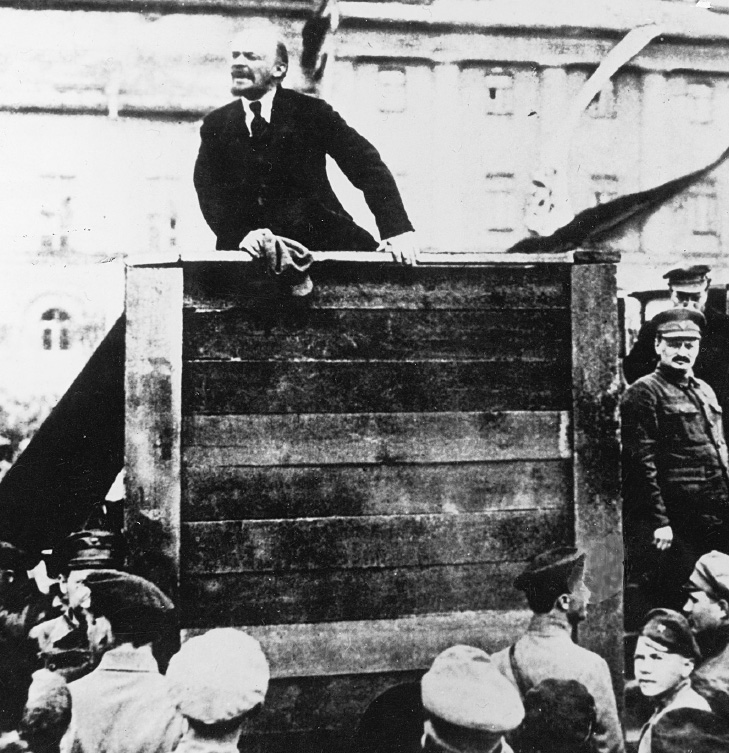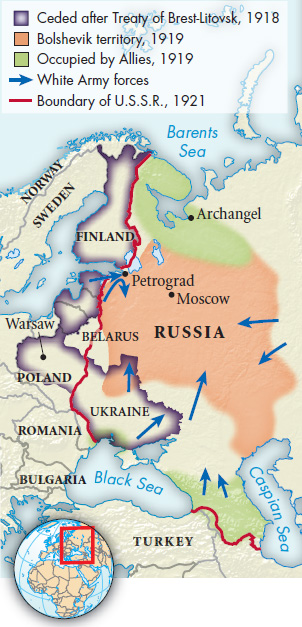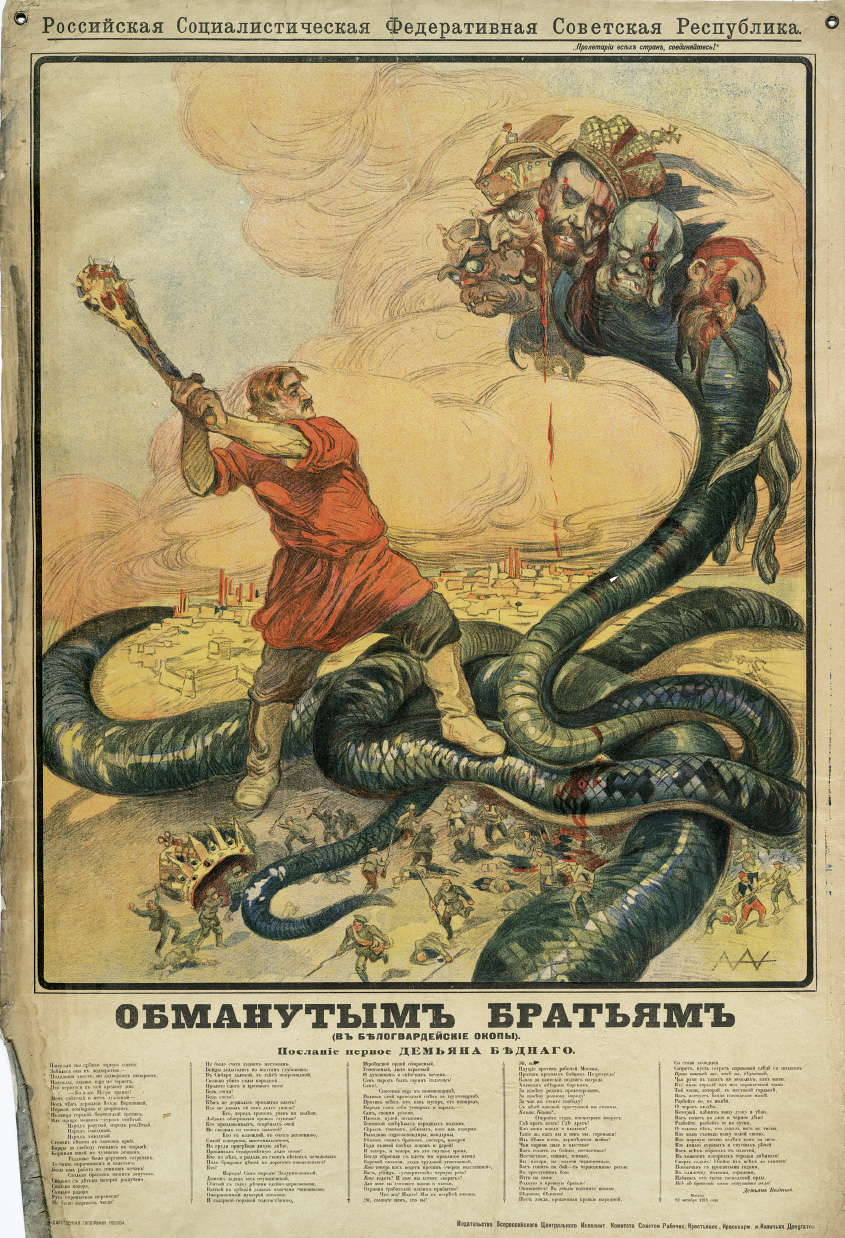A History of Western Society: Printed Page 845
A History of Western Society, Value Edition: Printed Page 854
Dictatorship and Civil War
The Bolsheviks’ truly monumental accomplishment was not taking power, but keeping it. Over the next four years, they conquered the chaos they had helped create and began to build a Communist society. How was this done?
Lenin had the genius to profit from developments over which the Bolsheviks had little control. Since summer, a peasant revolution had swept across Russia, as impoverished peasants had seized for themselves the estates of the landlords and the church. Thus when Lenin mandated land reform, he merely approved what peasants were already doing. Similarly, urban workers had established their own local soviets or committees and demanded direct control of individual factories. This, too, Lenin ratified with a decree in November 1917.
The Bolsheviks proclaimed their regime a “provisional workers’ and peasants’ government,” promising that a freely elected Constituent Assembly would draw up a new constitution. But free elections in November produced a stunning setback: the Bolsheviks won only 23 percent of the elected delegates. The Socialist Revolutionary Party — the peasants’ party — had a clear plurality with about 40 percent of the vote. After the Constituent Assembly met for one day, however, Bolshevik soldiers acting under Lenin’s orders disbanded it. By January 1918 Lenin had moved to establish a one-party state.

Lenin acknowledged that Russia had effectively lost the war with Germany and that the only realistic goal was peace at any price. That price was very high. Germany demanded that the Soviet government give up all its western territories, areas inhabited primarily by Poles, Finns, Lithuanians, and other non-Russians — people who had been conquered by the tsars over three centuries and put into the “prisonhouse of nationalities,” as Lenin had earlier called the Russian empire.

At first, Lenin’s fellow Bolsheviks refused to accept such great territorial losses. But when German armies resumed their unopposed march into Russia in February 1918, Lenin had his way in a very close vote. A third of old Russia’s population was sliced away by the Treaty of Brest-Litovsk, signed with Germany in March 1918. With peace, Lenin escaped the disaster of continued war and could pursue his goal of absolute power for the Bolsheviks — now also called Communists — within Russia.

The peace treaty and the abolition of the Constituent Assembly inspired armed opposition to the Bolshevik regime. People who had supported self-rule in November saw that once again they were getting dictatorship. The officers of the old army organized the so-called White opposition to the Bolsheviks in southern Russia, Ukraine, Siberia, and the area west of Petrograd. The Whites came from many social groups and were united only by their hatred of communism and the Bolsheviks — the Reds.
By the summer of 1918 Russia was in a full-fledged civil war. Eighteen self-proclaimed regional governments — several of which represented minority nationalities — challenged Lenin’s government in Moscow. By the end of the year White armies were on the attack. In October 1919 they closed in on central Russia from three sides, and it appeared they might triumph. They did not.
Lenin and the Red Army beat back the counter-revolutionary White armies for several reasons. Most important, the Bolsheviks had quickly developed a better army. Once again, Trotsky’s leadership was decisive. At first, the Bolsheviks had preached democracy in the military and had even elected officers in 1917. But beginning in March 1918, Trotsky became war commissar of the newly formed Red Army. He re-established strict discipline and the draft. Soldiers deserting or disobeying an order were summarily shot. Moreover, Trotsky made effective use of former tsarist army officers, who were actively recruited and given unprecedented powers over their troops. Trotsky’s disciplined and effective fighting force repeatedly defeated the Whites in the field.
Ironically, foreign military intervention helped the Bolsheviks. For a variety of reasons, but primarily to stop the spread of communism, the Western Allies (including the United States, Britain, France, and Japan) sent troops to support the White armies. Yet their efforts were limited and halfhearted. By 1919, with the Great War over, Westerners were sick of war, and few politicians wanted to get involved in a new military crusade. Allied intervention failed to offer effective aid, though it did permit the Bolsheviks to appeal to the patriotic nationalism of ethnic Russians, in particular former tsarist army officers who objected to foreign involvement in Russian affairs.
Other conditions favored a Bolshevik victory as well. Strategically, the Reds controlled central Russia and the crucial cities of Moscow and Petrograd. The Whites attacked from the fringes and lacked coordination. Moreover, the poorly defined political program of the Whites was a mishmash of liberal republicanism and monarchism incapable of uniting the Bolshevik’s enemies. And while the Bolsheviks promised ethnic minorities in Russian-controlled territories substantial autonomy, the nationalist Whites sought to preserve the tsarist empire.
The Bolsheviks mobilized the home front for the war by establishing a system of centralized controls called War Communism. The leadership nationalized banks and industries and outlawed private enterprise. Bolshevik commissars introduced rationing, seized grain from peasants to feed the cities, and maintained strict workplace discipline. Although normal economic activity broke down, these measures maintained labor discipline and kept the Red Army supplied with men and material.
Revolutionary terror also contributed to the Communist victory. Lenin and the Bolsheviks set up a fearsome secret police known as the Cheka, dedicated to suppressing counter-revolutionaries. During the civil war, the Cheka imprisoned and executed without trial tens of thousands of supposed “class enemies.” Victims included clergymen, aristocrats, the wealthy Russian bourgeoisie, deserters from the Red Army, and political opponents of all kinds. The tsar and his family were callously executed in July 1918. The “Red Terror” of 1918 to 1920 helped establish the secret police as a central tool of the new Communist government.
By the spring of 1920 the White armies were almost completely defeated, and the Bolsheviks had retaken much of the territory ceded to Germany under the Treaty of Brest-Litovsk. The Red Army reconquered Belarus and Ukraine, both of which had briefly gained independence. Building on this success, the Bolsheviks moved westward into Polish territory, but they were halted on the outskirts of Warsaw in August 1920 by troops under the leadership of the Polish field marshal and chief of state Jozef Pilsudski. This defeat halted Bolshevik attempts to spread communism further into Europe, though in 1921 the Red Army overran the independent national governments of the Caucasus. The Russian civil war was over, and the Bolsheviks had won an impressive victory.